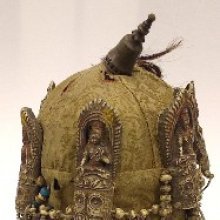Science, Scientific: 4 definitions
Introduction:
Science means something in Hinduism, Sanskrit, the history of ancient India, Hindi. If you want to know the exact meaning, history, etymology or English translation of this term then check out the descriptions on this page. Add your comment or reference to a book if you want to contribute to this summary article.
Images (photo gallery)
(+3 more images available)
In Hinduism
Vastushastra (architecture)
Source: archive.org: Bharatiya vastu-sastraScience (of Architecture).—In India we can not draw a line of demarcation between Science and Philosophy. The truth is, a science without a philosophy or religious background is not a complete science, according to Hindu view of life. It is in keeping with the fundamental background of the Indian science that even such a practical or matter of fact science as the science of architecture is, has such a lofty philosophical theory as ‘Vāstu-brahma-vāda’ or ‘Vāstu-puruṣa-vāda’ as its background. The growth and evolution of the temple, the chief feature of Indian architecture both in the ancient and medieval periods of Indian History, represents this ideal of the architectural science from the bottom to the top (vide Part V. the prāsāda-vāstu).

Vastushastra (वास्तुशास्त्र, vāstuśāstra) refers to the ancient Indian science (shastra) of architecture (vastu), dealing with topics such architecture, sculpture, town-building, fort building and various other constructions. Vastu also deals with the philosophy of the architectural relation with the cosmic universe.
Ayurveda (science of life)
Source: Shodhganga: Plant mutagenesis in ancient IndiaThe Scientific temperament of the ancient Hindus is proved by the numerous scientific treatises that have come down through the ages. They experimented to great depths in order to disover the laws of the nature as well as to use them to their advantage. One such science is the science of druma-vicitrī-karaṇa, i.e., “plant mutagenesis”— a branch of hroticulture. This is akin to the modern day plant biotechnology. The objectives of the ancient science are almost silimar to the objectioves being deal by the modern biotechnologists.

Āyurveda (आयुर्वेद, ayurveda) is a branch of Indian science dealing with medicine, herbalism, taxology, anatomy, surgery, alchemy and related topics. Traditional practice of Āyurveda in ancient India dates back to at least the first millenium BC. Literature is commonly written in Sanskrit using various poetic metres.
India history and geography
Source: archive.org: Hindu Mathematics (History)Books on the Exact sciences were translated from Sanskrit and transmitted to Arab literature.—The foundations of Arabic literature and science were laid between 750-850 A.D. This was done chiefly with the aid of foreigners and with foreign material. The bulk of their narrative literature came to the Arabs in translation from Persian. Books on the science of war, the knowledge of weapons, the veterinary art, falconry, and the various methods of divination, and some books on medicine were translated from Sanskrit and Persian. They got the exact sciences from Greece and India.

The history of India traces the identification of countries, villages, towns and other regions of India, as well as mythology, zoology, royal dynasties, rulers, tribes, local festivities and traditions and regional languages. Ancient India enjoyed religious freedom and encourages the path of Dharma, a concept common to Buddhism, Hinduism, and Jainism.
Languages of India and abroad
Hindi dictionary
Source: DDSA: A practical Hindi-English dictionaryScience in Hindi refers in English to:—(nf) science; ~[dam] a scientist..—science (साइंस) is alternatively transliterated as Sāiṃsa.
...
See also (Relevant definitions)
Starts with: Elephantology.
Query error!
Full-text (+11990): Ayurveda, Ganita, Shastra, Dandaniti, Vaidyaka, Arthashastra, Tarkavidya, Jyotisha, Vidya, Shiksha, Dhanurveda, Vedanga, Nitishastra, Anvikshiki, Vaijnanika, Upavidya, Tarkashastra, Kamashastra, Vastushastra, Shabdavidya.
Relevant text
Search found 459 books and stories containing Science, Sciences, Scientific, The science; (plurals include: Sciences, Scienceses, Scientifics, The sciences). You can also click to the full overview containing English textual excerpts. Below are direct links for the most relevant articles:
Has India at present any Philosophy’, as such, of Her Own? < [Jan-Feb 1940]
The Value of Philosophy < [January – March, 1996]
A Scientific Approach to Religion < [July – September, 1993]
Contemporary Perspectives on Ayurveda: Evolving Science and Philosophy < [Volume 2, issue 1: January - February 2015]
Correlation of Ayurveda and Astrology on Health < [Volume 9, Suppl 1: July-Aug 2022]
Scientific validation of Ayurvedic prakriti: current evidence. < [Volume 2, issue 5: Sept - Oct 2015]
Significance of the Moon in Ancient Civilizations (by Radhakrishnan. P)
16. Conclusion < [Chapter 15 - Conclusion]
1. Mind in Vedanta < [Chapter 7 - Moon the Significant Planet of Mind]
Manusmriti with the Commentary of Medhatithi (by Ganganatha Jha)
Verse 7.43 < [Section IV - Duties of the King]
Verse 4.19 < [Section III - The Observances of the Accomplished Student]
Verse 2.168 < [Section XXVIII - Course and Method of Study]
Chandogya Upanishad (Madhva commentary) (by Srisa Chandra Vasu)
Seventh Adhyaya, First Khanda (5 mantras)
Introduction to the Chandogya Upanishad
Manasollasa (study of Arts and Sciences) (by Mahadev Narayanrao Joshi)
1. Introduction to science in ancient India < [Chapter 5 - Sciences in Someshvara’s Manasollasa]
3. Mathematics in Manasollasa < [Chapter 5 - Sciences in Someshvara’s Manasollasa]
4. Ancient Indian sciences and medieval Europe < [Chapter 5 - Sciences in Someshvara’s Manasollasa]
Related products
(+136 more products available)











